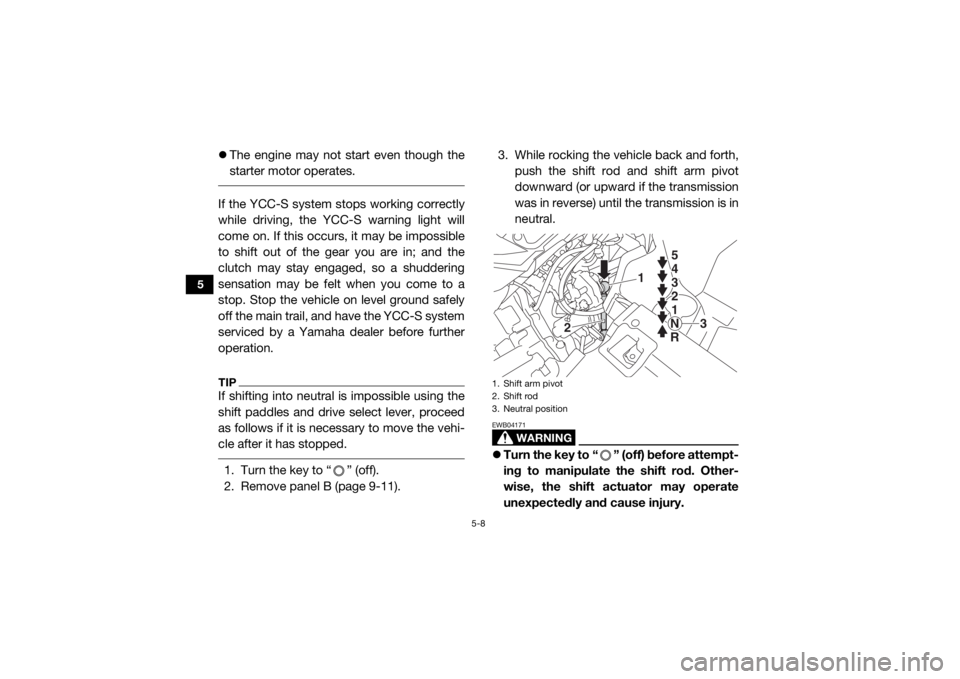stop start YAMAHA YXZ1000R SS 2020 Owners Manual
[x] Cancel search | Manufacturer: YAMAHA, Model Year: 2020, Model line: YXZ1000R SS, Model: YAMAHA YXZ1000R SS 2020Pages: 212, PDF Size: 9.36 MB
Page 36 of 212

5-4
5
and/or turn the steering wheel back and
forth to help the differential to lock or un-
lock. EBU34932Shift light
This light can be set to come on and go off at
the desired engine speeds and is used to in-
form the driver when it is time to upshift.
The electrical circuit of the shift light can be
checked by turning the key to “ ” (on). If the
light does not come on initially when the key
is turned to “ ” (on), or if the light remains
on, have a Yamaha dealer check the electrical
circuit.TIPSee page 5-16 for an explanation of how to
set the shift light.
EBU35283Coolant temperature warning light “ ”
This warning light comes on when the coolant
temperature, and therefore the engine, is out-
side its normal operating temperature range.
The warning light comes on in blue to inform
the driver that the vehicle should be warmed
up. After the engine is started, warm it up until
the warning light goes off.
The vehicle can be operated normally when
the warning light is off.
The warning light comes on in red when the
engine is overheating. If the red light comes
on, stop the vehicle as soon as it is safe to do
so and allow the engine to idle for about 10
minutes. If the warning light does not go off,
stop the engine and allow it to cool. (See page
9-71.)TIPIf you continue to drive the vehicle while the
engine is overheating, a buzzer will sound.
UBAS7AE0.book Page 4 Wednesday, June 19, 2019 11:51 AM
Page 39 of 212

5-7
5
EBU36643Launch system indicator light “ ”
This indicator light comes on when the launch
system is activated. If the indicator light is
flashing, either a user error or system restric-
tion has been detected. See “Launch system
operation” on page 7-7 for more information.
The electrical circuit of the indicator light can
be checked by turning the key to “ ” (on). If
the indicator light does not come on and then
go off, have a Yamaha dealer check the elec-
trical circuit.TIPIf the launch system indicator light is flashing,
release the accelerator pedal and shift pad-
dles to reset the system. When the engine
speed returns to idle, the indicator light will go
off. You can now start off as normal in first
gear, or retry activating the launch system.
EBU36743YCC-S system warning light “ ”
This warning light comes on when an error
has occurred or a malfunction has been de-
tected in the YCC-S system. Have a Yamaha
dealer check the YCC-S system.
The electrical circuit of the YCC-S system
warning light can be checked by turning the
key to “ ” (on). If the warning light does not
come on and then go off, have a Yamaha
dealer check the electrical circuit.
If the YCC-S system warning light flashes
when starting the engine, wait 3 seconds for
the light to stop flashing, and then retry start-
ing the engine. If an error in the YCC-S sys-
tem prevents the engine from starting, the
warning light will come and the display will in-
dicate an error code.TIPYCC-S system error codes are visible only
when the engine is stopped.
UBAS7AE0.book Page 7 Wednesday, June 19, 2019 11:51 AM
Page 40 of 212

5-8
5
The engine may not start even though the
starter motor operates. If the YCC-S system stops working correctly
while driving, the YCC-S warning light will
come on. If this occurs, it may be impossible
to shift out of the gear you are in; and the
clutch may stay engaged, so a shuddering
sensation may be felt when you come to a
stop. Stop the vehicle on level ground safely
off the main trail, and have the YCC-S system
serviced by a Yamaha dealer before further
operation.TIPIf shifting into neutral is impossible using the
shift paddles and drive select lever, proceed
as follows if it is nece ssary to move the vehi-
cle after it has stopped. 1. Turn the key to “ ” (off).
2. Remove panel B (page 9-11). 3. While rocking the vehicle back and forth,
push the shift rod and shift arm pivot
downward (or upward if the transmission
was in reverse) until the transmission is in
neutral.
WARNING
EWB04171Turn the key to “ ” (off) before attempt-
ing to manipulate the shift rod. Other-
wise, the shift actuator may operate
unexpectedly and cause injury.1. Shift arm pivot
2. Shift rod
3. Neutral position
1
2
3
5 5
4
3
2
1
N
R 5
4
3
2
1
N
R
UBAS7AE0.book Page 8 Wednesday, June 19, 2019 11:51 AM
Page 96 of 212
![YAMAHA YXZ1000R SS 2020 Owners Manual 7-4
7
TIPTo use the drive select lever, you must be
pressing the brake pedal and be stopped
(be traveling less than 5 km/h [3 mph]), and
the engine should be at idle speed.
You can shift betwee YAMAHA YXZ1000R SS 2020 Owners Manual 7-4
7
TIPTo use the drive select lever, you must be
pressing the brake pedal and be stopped
(be traveling less than 5 km/h [3 mph]), and
the engine should be at idle speed.
You can shift betwee](/img/51/53897/w960_53897-95.png)
7-4
7
TIPTo use the drive select lever, you must be
pressing the brake pedal and be stopped
(be traveling less than 5 km/h [3 mph]), and
the engine should be at idle speed.
You can shift between forward (first gear)
and reverse gear directly - it is not neces-
sary to shift into neutral.
When using the shift paddles, YCC-S may
not complete the upshift if engine or vehicle
speed is too low, nor complete the down-
shift if engine or vehicle speed is too high.
When AUTO DOWNSHIFT is downshifting
gears, do not operate the shift paddles or
accelerator pedal.
During an emergency stop or sudden brak-
ing, AUTO DOWNSHIFT will not downshift
the transmission to first gear. Use the shift
paddle “ ” to downshift, and then apply
the accelerator pedal to resume normal op-
eration.
NOTICEECB03370Even with the transmission in the neutral
position, do not coast for long periods of
time with the engine off. The transmission
is properly lubricated only when the engine
is running. Inadequate lubrication may
damage the transmission. To start out and accelerate
1. Take your foot off the accelerator pedal
and apply the brake pedal. NOTICE: Al-
ways take your foot off the accelerator
pedal before operating the drive select
lever, otherwise damage to the engine
and drivetrain may result.
[ECB03360]
2. Release the parking brake (if applied).
3. Shift into first gear using the drive select lever (the transmission gear display
should show “1”).
4. Release the brake pedal and press the accelerator pedal gradually.
UBAS7AE0.book Page 4 Wednesday, June 19, 2019 11:51 AM
Page 119 of 212

8-14
8
Getting ready to ride
Perform the pre-operation checks on page
6-1. Follow the instructions on page 7-2 when
starting the engine.
Turning
Use care in turns — turning the steering wheel
too far or too fast can result in loss of control
or a rollover. Slow down before entering
turns. When making tight turns from a stand-
still or at slow speeds, avoid sudden or hard
acceleration. Driving aggressively or making
abrupt maneuvers even on flat, open areas
can cause side rollovers. Avoid sideways slid-
ing, skidding, or fishtailing (rear-wheel slid-
ing), and never do donuts. If you feel the
vehicle begin to slide sideways or the rear
wheels begin to slide during a turn, steer into
the direction of the slide, if possible, and
gradually let off the accelerator pedal to re-
gain directional control and avoid rollover. For
example, if you feel the back of the vehicle
start to slide to your right, steer to the right. If you think or feel that the vehicle may tip or
roll, keep your body completely inside the
protective structure of the vehicle:
Brace yourself by pressing your feet firmly
on the floorboard and keep a firm grip on
the steering wheel or passenger handhold.
Do not put your hands or feet outside of the
vehicle for any reason. Do not try to stop a
tipover using your arm or leg.
Accelerating
Avoid higher speeds and sudden or hard ac-
celeration until you are thoroughly familiar
with the operation of your vehicle. Avoid sud-
den or hard acceleration in any turn. Never
drive faster than is safe for current conditions.
Shifting
Follow the instructions on pages 7-2 and 7-3
for shifting, downshifting, and shifting into re-
verse until you are thoroughly familiar with
each operation.UBAS7AE0.book Page 14 Wednesday, June 19, 2019 11:51 AM
Page 123 of 212

8-18
8
sense and remember that some hills are too
steep for you to climb or descend. Use proper
driving techniques to avoid rearward, for-
ward, or sideways rollovers on hills and
slopes.
Drive straight up and down inclines, not
across them. If crossing a hill is unavoidable,
drive slowly. Turn downhill immediately if you
feel the vehicle may tip.
If you think or feel the vehicle may tip or
roll:
Brace yourself by pressing your feet firmly
on the floorboard and keep a firm grip on
the steering wheel or passenger handhold.
Do not put your hands or feet outside of the
vehicle for any reason.
Uphill
Do not attempt to climb hills until you have
mastered basic maneuv ers on flat ground.
Drive straight up hills, and avoid crossing the
side of a hill, which increases your risk of roll- over. Practice first on gentle slopes before at-
tempting steeper hills. Always check the
terrain carefully before attempting any hill.
To climb a hill, you need traction, momentum,
and steady throttle. For more traction and
control for climbing steeper and/or rougher
slopes, shift into low gear and select “4WD”
or “DIFF LOCK”. Travel fast enough to main-
tain momentum, but not so fast that you can-
not react to changes in the terrain as you
climb.
Slow down when you reach the crest of the
hill if you cannot see clearly what is on the
other side – there could be another person, an
obstacle, or a sharp drop-off.
If you start to lose traction or momentum
when climbing, and decide you will be unable
to continue, use the brakes to stop. Do not at-
tempt to turn the vehicle around. With your
foot on the brake pedal, look behind you and
plan your descent. Shift the transmission into
reverse so you can use engine braking to
slow your descent. Release the brake, andUBAS7AE0.book Page 18 Wednesday, June 19, 2019 11:51 AM
Page 126 of 212

8-21
8
If you feel the vehicle begin to slide sideways
or fishtail (rear-wheel sliding), steer into the di-
rection of the slide if possible, to regain direc-
tional control. For example, if you feel the
back of the vehicle start to slide to your right,
steer to the right.
Brush or wooded areas
When operating in areas with brush or trees,
watch carefully on both sides and above the
vehicle for obstacles such as branches that
the vehicle might hit, causing an accident.
Watch for brush that might enter the vehicle
as you pass and strike you or the passenger.
Never hold onto the cage/frame. The passen-
ger should always hold onto the passenger
handhold with both hands.
The muffler and other engine parts become
extremely hot during operation and remain
hot after the engine has stopped. To reduce
the risk of fire during operation or after leaving
the vehicle, do not let brush, grass and other
materials collect under the vehicle, near the muffler or exhaust pipe, or next to other hot
parts. Check under the vehicle after operating
in areas where combustible materials may
have collected. Do not idle or park the vehicle
in long dry grass or other dry ground cover.
Encountering obstacles
If you cannot go around an obstacle, such as
a fallen tree or a ditch, stop the vehicle where
it is safe to do so. Set the parking brake and
get out to inspect the area thoroughly. Look
from both your approach side and exit side. If
you believe you can continue safely, choose
the path that will allow you to get over the ob-
stacle and at as close to a right angle as pos-
sible to minimize vehicle tipping. Go only fast
enough to maintain your momentum but still
give yourself plenty of time to react to chang-
es in conditions.UBAS7AE0.book Page 21 Wednesday, June 19, 2019 11:51 AM
Page 150 of 212

9-23
9
TIPBe sure to wipe off spilled oil on any parts af-
ter the engine and exhaust system have
cooled down. 16. Install and tighten the engine oil tank fillercap.
17. Start the engine and let it idle for several minutes. During this time, check for oil
leakage. If any oil leaks are found, stop
the engine and check for the cause.
18. Stop the engine, wait at least ten minutes, and then check the oil level one last time.
19. Install the engine oil tank cover by install- ing the bolts.
20. Install the panel.
To change the engine oil and oil filter
1. Park the vehicle on a level surface.
2. Loosen the left and right side panels by removing the bolt as shown. 3. Remove the rear bottom panel by remov-
ing the bolts.
1. Left side panel
2. Right side panel
3. Bolt
3
1
3
2
UBAS7AE0.book Page 23 Wednesday, June 19, 2019 11:51 AM
Page 158 of 212

9-31
9
TIPOil will flow out immediately when the drain
bolt is loosened. Take care not to lose the
bolt. 4. After draining the oil, install the transmis-sion oil drain bolt with a new gasket.
5. Tighten the drain bolt to the specified torque. 6. Check the O-ring for damage, and re-
place it if necessary.
7. Refill the transmission with the specified amount of the recommended oil.
8. Install the transmission oil filler cap.
9. Start the engine and let it idle while checking for oil leakage.
10. Stop the engine and check the oil level one last time.
EBU36054Final gear oilCheck the oil level and change the final gear
oil at the intervals specified in the periodic
maintenance chart.
1. Transmission oil drain bolt
2. Gasket2
1
Tightening torque:Transmission oil drain bolt:20 N·m (2.0 kgf·m, 15 lb·ft)
UBAS7AE0.book Page 31 Wednesday, June 19, 2019 11:51 AM
Page 173 of 212

9-46
9
EBU35141Cleaning the spark arrester
WARNING
EWB03370Hot exhaust system may cause burns. To
avoid burns or fires, make sure that the en-
gine is stopped and the exhaust system is
cool before cleaning the spark arrester. Do
not start the engine while cleaning the ex-
haust system. 1. Remove the tailpipe cover by removingthe tailpipe cover bolts. 2. Remove the tailpipe bolts.
3. Remove the tailpipe by pulling it out of
the muffler, and then remove the gasket.
4. Tap the tailpipe lightly, and then use a wire brush to remove any carbon depos-
its from the spark arrester portion of the
tailpipe and inside of the tailpipe housing.1. Tailpipe cover
2. Tailpipe cover bolt
1
2
2
1. Tailpipe bolt
1
1
UBAS7AE0.book Page 46 Wednesday, June 19, 2019 11:51 AM